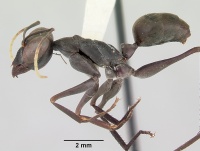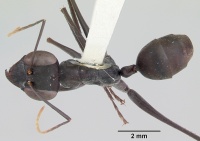Gigantiops
| Gigantiops | |
|---|---|

| |
| Gigantiops destructor | |
| Scientific classification | |
| Kingdom: | Animalia |
| Phylum: | Arthropoda |
| Class: | Insecta |
| Order: | Hymenoptera |
| Family: | Formicidae |
| Subfamily: | Formicinae |
| Tribe: | Gigantiopini |
| Genus: | Gigantiops Roger, 1863 |
| Type species | |
| Formica destructor, now Gigantiops destructor | |
| Diversity | |
| 1 species (Species Checklist, Species by Country) | |
A monotypic genus found in northern South America, Gigantiops destructor has garnered attention from tropical biologists due to their large eyed, large workers that leap around on the vegetation. These ants forage individually, have well developed jumping abilities and due to their keen eyesight are adept at avoiding capture by all but the most persistent myrmecologists.
| At a Glance | • Monotypic • Jumping ants |
Photo Gallery
Identification
In full face view the eyes of the worker extend from the clypeal border to the posterior margin. The large eyes of this ant make it distinctive among all ants in the subfamily Formicinae.
| See images of species within this genus |
Distribution
Distribution and Richness based on AntMaps
Species by Region
Number of species within biogeographic regions, along with the total number of species for each region.
| Afrotropical Region | Australasian Region | Indo-Australian Region | Malagasy Region | Nearctic Region | Neotropical Region | Oriental Region | Palaearctic Region | |
|---|---|---|---|---|---|---|---|---|
| Species | 0 | 0 | 0 | 0 | 0 | 1 | 0 | 0 |
| Total Species | 2841 | 1736 | 3045 | 932 | 835 | 4379 | 1741 | 2862 |
Biology
See Gigantiops destructor, the only known species within this genus.
Castes
Morphology
Worker Morphology
 Explore: Show all Worker Morphology data or Search these data. See also a list of all data tables or learn how data is managed.
Explore: Show all Worker Morphology data or Search these data. See also a list of all data tables or learn how data is managed.
• Antennal segment count: 12 • Antennal club: absent • Palp formula: 6,4 • Spur formula: 1 simple, 1 simple • Eyes: >100 ommatidia • Scrobes: absent • Pronotal Spines: absent • Mesonotal Spines: absent • Propodeal Spines: absent • Petiolar Spines: absent • Caste: none or weak • Sting: absent • Metaplural Gland: present • Cocoon: present
Morphology
Karyotype
All Karyotype Records for Genus
 Explore: Show all Karyotype data or Search these data. See also a list of all data tables or learn how data is managed.
Explore: Show all Karyotype data or Search these data. See also a list of all data tables or learn how data is managed.
| Taxon | Haploid | Diploid | Karyotype | Locality | Source | Notes |
|---|---|---|---|---|---|---|
| Gigantiops destructor | 78 | 10M+66T | French Guiana | Mariano et al., 2011 |
Phylogeny
| Formicinae |
| |||||||||||||||||||||||||||||||||||||||||||||||||||||||||||||||||||||||||||||||||||||||||||||||||||||||||||||||||||||||||||||||||||||||||||||||||||||||||||||||||||||||||||||||||||||||||||||||||||||||||||||||||||||||||||||||||||||||||||||||||||||||||||||||||||||||||||||||||
See Phylogeny of Formicinae for details.
Phylogeny
| Formicinae |
| |||||||||||||||||||||||||||||||||||||||||||||||||||||||||||||||||||||||||||||||||||||||||||||||||||||||||||||||||||||||||||||||||||||||||||||||||||||||||||||||||||||||||||||||||||||||||||||||||||||||||||||||||||||||||||||||||||||||||||||||||||||||||||||||||||||||||||||||||
See Phylogeny of Formicinae for details.
Nomenclature
The following information is derived from Barry Bolton's Online Catalogue of the Ants of the World.
- GIGANTIOPS [Formicinae: Gigantiopini]
- Gigantiops Roger, 1863b: 11. Type-species: Formica destructor, by monotypy.
Ward (2016) - A molecular phylogenetic analysis shows Gigantiops as sister to Santschiella, a monotypic African genus, but support for this relationship is not strong, so we retain a separate tribe for Santschiella. Although both genera share distinctively large eyes, they differ markedly in configuration of the frontoclypeal complex, with the antennal insertions of Gigantiops being located close to one another and between the eyes (Bolton 2003).
References
- Agosti, D. 1991. Revision of the oriental ant genus Cladomyrma, with an outline of the higher classification of the Formicinae (Hymenoptera: Formicidae). Syst. Entomol. 16: 293-310. (page 295, Gigantiops in Formicinae, Oecophylla genus group.)
- Ashmead, W. H. 1905c. A skeleton of a new arrangement of the families, subfamilies, tribes and genera of the ants, or the superfamily Formicoidea. Can. Entomol. 37: 381-384 (page 384, Gigantiops in Gesomyrmicinae, Gigantiopini)
- Bolton, B. 1994. Identification guide to the ant genera of the world. Cambridge, Mass.: Harvard University Press, 222 pp. (page 50, Gigantiops in Formicinae, Gigantiopini)
- Bolton, B. 2003. Synopsis and Classification of Formicidae. Mem. Am. Entomol. Inst. 71: 370pp (page 111, Gigantiops in Formicinae, Gigantiopini)
- Boudinot, B.E. 2019. Hormigas de Colombia. Cap. 15. Clave para las subfamilias y generos basada en machos. Pp. 487-499 in: Fernández, F., Guerrero, R.J., Delsinne, T. (eds.) 2019d. Hormigas de Colombia. Bogotá: Universidad Nacional de Colombia, 1198 pp.
- Cantone S. 2018. Winged Ants, The queen. Dichotomous key to genera of winged female ants in the World. The Wings of Ants: morphological and systematic relationships (self-published).
- Dalla Torre, K. W. von. 1893. Catalogus Hymenopterorum hucusque descriptorum systematicus et synonymicus. Vol. 7. Formicidae (Heterogyna). Leipzig: W. Engelmann, 289 pp. (page 175, Gigantiops in Camponotinae )
- Emery, C. 1895l. Die Gattung Dorylus Fab. und die systematische Eintheilung der Formiciden. Zool. Jahrb. Abt. Syst. Geogr. Biol. Tiere 8: 685-778 (page 772, Gigantiops in Camponotinae, Oecophyllini)
- Emery, C. 1925d. Hymenoptera. Fam. Formicidae. Subfam. Formicinae. Genera Insectorum 183: 1-302 (page 48, Gigantiops in Formicinae, Gigantiopini)
- Fernandez, F., Guerrero, R.J., Sánchez-Restrepo, A.F. 2021. Sistemática y diversidad de las hormigas neotropicales. Revista Colombiana de Entomología 47, 1–20 (doi:10.25100/socolen.v47i1.11082).
- Forel, A. 1878c. Études myrmécologiques en 1878 (première partie) avec l'anatomie du gésier des fourmis. Bull. Soc. Vaudoise Sci. Nat. 15: 337-392 (page 370, Gigantiops in Camponotinae [Camponotidae])
- Klimeš, P., Drescher, J., Buchori, D., Hidayat, P., Nazarreta, R., Potocký, P., Rimandai, M., Scheu, S., Matos-Maraví, P. 2022. Uncovering cryptic diversity in the enigmatic ant genus Overbeckia and insights into the phylogeny of Camponotini (Hymenoptera:Formicidae:Formicinae). Invertebrate Systematics, 36(6), 557-579 (doi:10.1071/is21067).
- Mayr, G. 1865. Formicidae. In: Reise der Österreichischen Fregatte "Novara" um die Erde in den Jahren 1857, 1858, 1859. Zoologischer Theil. Bd. II. Abt. 1. Wien: K. Gerold's Sohn, 119 pp. (page 9, Gigantiops in Formicinae [Formicidae])
- Roger, J. 1863b. Verzeichniss der Formiciden-Gattungen und Arten. Berl. Entomol. Z. 7(B Beilage: 1-65 (page 11, Gigantiops as genus)
- Ward, P.S., Blaimer, B.B., Fisher, B.L. 2016. A revised phylogenetic classification of the ant subfamily Formicinae (Hymenoptera: Formicidae), with resurrection of the genera Colobopsis and Dinomyrmex. Zootaxa. 4072(3):343–357. (doi 10.11646/zootaxa.4072.3.4).
- Wheeler, W. M. 1910b. Ants: their structure, development and behavior. New York: Columbia University Press, xxv + 663 pp. (page 143, Gigantiops in Camponotinae, Oecophyllini)
- Wheeler, W. M. 1922i. Ants of the American Museum Congo expedition. A contribution to the myrmecology of Africa. VII. Keys to the genera and subgenera of ants. Bull. Am. Mus. Nat. Hist. 45: 631-710 (page 700, Gigantiops in Formicinae, Gigantiopini)




